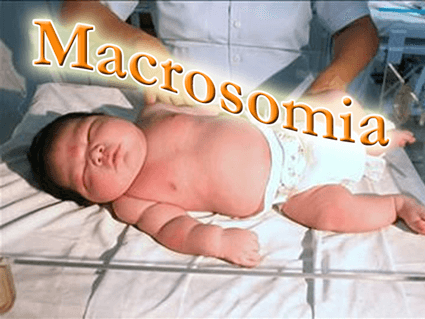Macrosomia
- Definition: Birth weight greater than 4000 g or above the 90th percentile for gestational age
- Causes: Maternal diabetes or obesity, excessive weight gain during pregnancy, prolonged pregnancy (>40 weeks), male gender, genetic factors
- Signs and symptoms: Large size for gestational age (LGA), plump or full face, birth trauma (e.g., shoulder dystocia, brachial plexus injury), hypoxemia (low oxygen level in blood), hypoglycemia, hypocalcemia (low calcium level in blood), polycythemia (high red blood cell count), hyperbilirubinemia
- Assessment: Measure weight, length, head circumference; monitor vital signs and oxygen saturation; assess for signs of trauma or injury; perform heel stick blood glucose test using a glucometer; perform laboratory tests as ordered (e.g., blood gas analysis, calcium level, hematocrit); perform diagnostic tests as ordered (e.g., chest X-ray)
- Nursing interventions: Deliver the baby vaginally with assistance if needed (e.g., forceps, vacuum extraction) or by cesarean section if indicated; provide oxygen therapy if needed; maintain thermoregulation by keeping the baby warm and dry; feed the baby as soon as possible after birth; monitor blood glucose levels frequently until stable; administer IV dextrose solution if needed; monitor calcium levels and administer calcium gluconate if needed; monitor hematocrit levels and perform partial exchange transfusion if needed; monitor bilirubin levels and provide phototherapy if needed; educate parents on signs of hypoglycemia and how to feed the baby

Nursing Test Bank
Quiz #1: RN Exams Pharmacology Exams
Quiz #2: RN Exams Medical-Surgical Exams
Quiz #3: RN Exams Fundamentals Exams
Quiz #4: RN Exams Maternal-Newborn Exams
Quiz #5: RN Exams Anatomy and Physiology Exams
Quiz #6: RN Exams Obstetrics and Pediatrics Exams
Quiz #7: RN Exams Fluid and Electrolytes Exams
Quiz #8: RN Exams Community Health Exams
Quiz #9: RN Exams Promoting Health across the lifespan Exams
Quiz #10: RN Exams Multidimensional care Exams
Naxlex Comprehensive Predictor Exams
Quiz #1: Naxlex RN Comprehensive online practice 2019 B with NGN
Quiz #2: Naxlex RN Comprehensive Predictor 2023
Quiz #3: Naxlex RN Comprehensive Predictor 2023 Exit Exam A
Quiz #4: Naxlex HESI Exit LPN Exam
Quiz #5: Naxlex PN Comprehensive Predictor PN 2020
Quiz #6: Naxlex VATI PN Comprehensive Predictor 2020
Quiz #8: Naxlex PN Comprehensive Predictor 2023 - Exam 1
Quiz #10: Naxlex HESI PN Exit exam
Quiz #11: Naxlex HESI PN EXIT Exam 2
Questions on Macrosomia
Correct Answer is B
Explanation
<p>Auscultating the lungs for crackles or wheezes is a way to check for a possible respiratory distress, not a brachial plexus injury.</p>
Correct Answer is C
Explanation
No explanation
Correct Answer is A
Explanation
White blood cell count of 9,000/mm3 is within the normal range for a newborn, which is 9,000 to 30,000/mm3.
turning off the phototherapy lights during blood draws can reduce the efficacy of the treatment and prolong the duration of exposure. The lights should be turned off only when absolutely necessary, such as during physical examination or parental bonding.
Rice cereal or oatmeal are not appropriate for newborns, as they can cause choking, allergies, or overfeeding.
Search Here
Related Topics
More on Nursing
Free Nursing Study Materials
Access to all study guides and practice questions for nursing for free.
- Free Nursing Study Trials
- Free Nursing Video tutorials
- Free Nursing Practice Tests
- Free Exam and Study Modes
- Free Nursing Revision Quizlets
